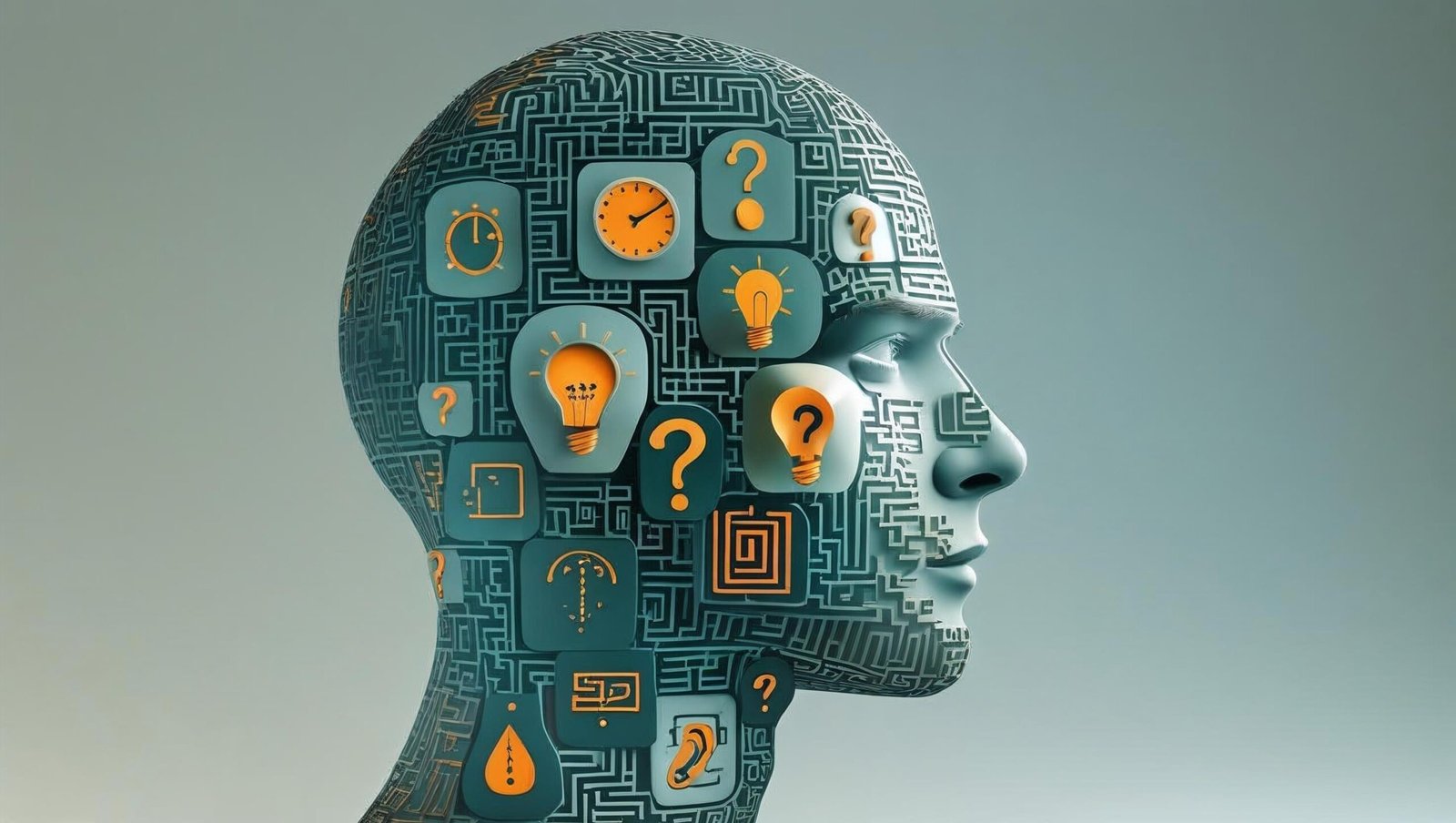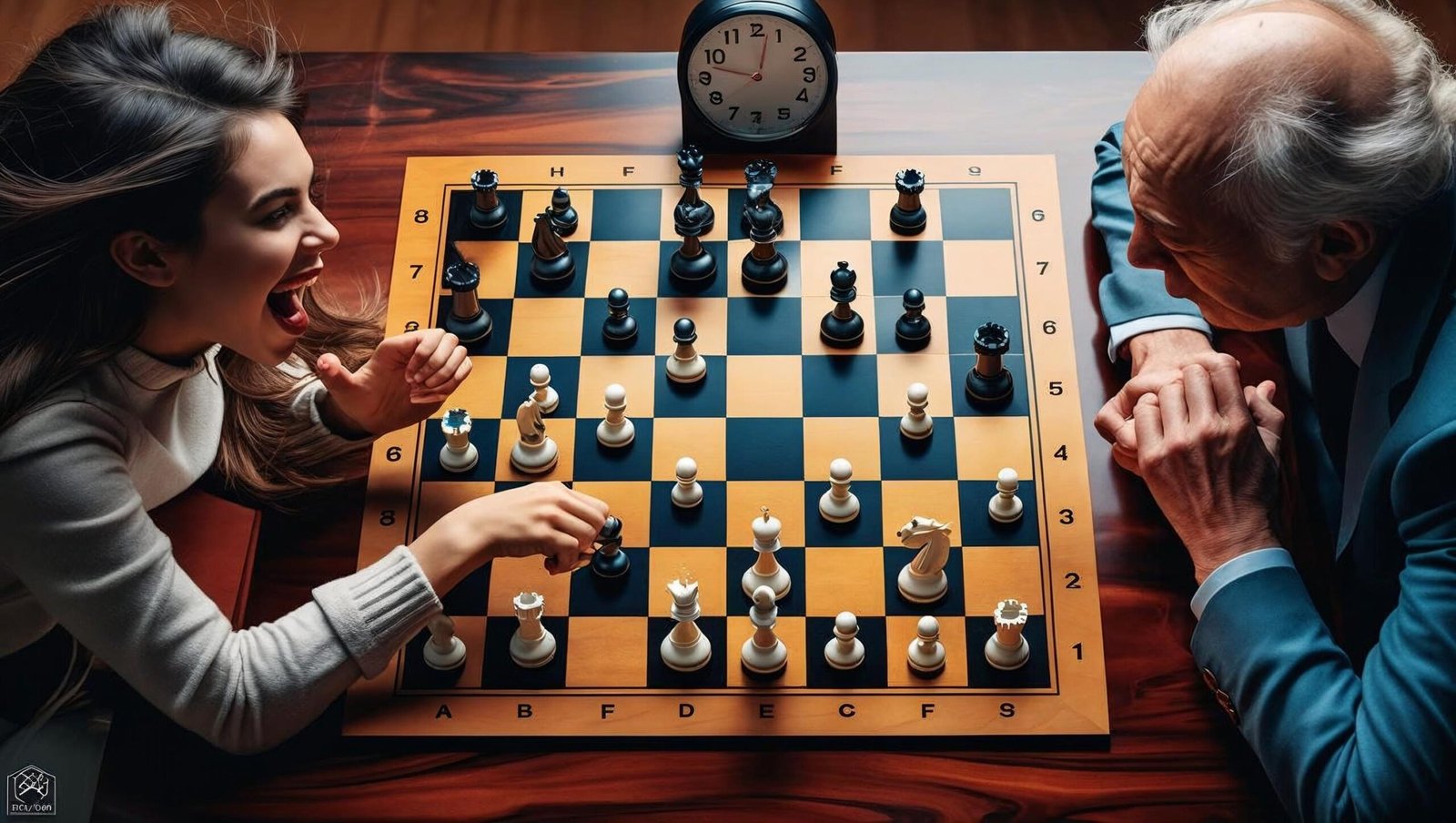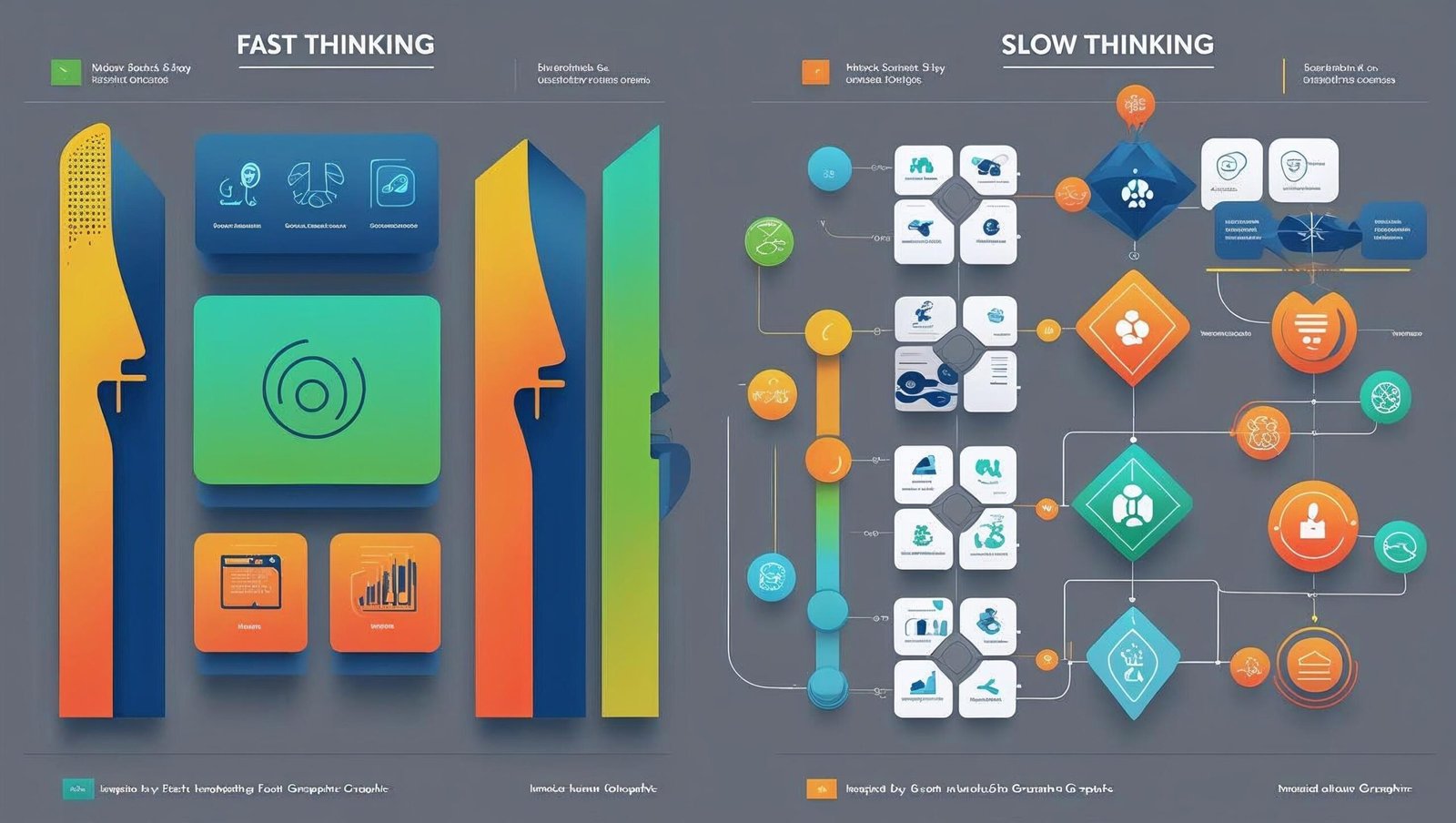Introduction
Thinking Fast and Slow by Daniel Kahneman, a Nobel laureate in Economic Sciences, is a seminal work that dissects the dual-process theory of the mind. Divided into five distinct parts, this book navigates through the complexities of human thinking by categorizing it into two modes—System 1 (fast, intuitive) and System 2 (slow, deliberate). In this blog post, we explore the core concepts, chapter-wise insights, and practical takeaways that can transform your understanding of decision-making, judgment, and rationality. With over 16,000 words of analysis, this review is designed to help readers, bloggers, and thinkers absorb and apply the principles of Thinking Fast and Slow effectively.

Part I: Two Systems
Daniel Kahneman begins Thinking Fast and Slow by introducing the foundational concept that underpins the entire book: the existence of two distinct modes of thinking. These systems, though metaphorical rather than anatomical, are vital in understanding how humans process information, make decisions, and interpret the world around them.
System 1: The Fast Thinker
System 1 operates automatically and quickly, with little or no effort and no sense of voluntary control. It is the default mode of thinking we rely on in everyday life. When you instinctively know the answer to “2 + 2,” or when you recoil at a sudden loud noise, it’s System 1 at work. This system is incredibly efficient for tasks that are routine or familiar.
Kahneman argues that System 1 is essential for survival—it evolved to make split-second decisions in environments where slow thinking could be fatal. It enables us to read emotions, detect danger, and perform learned skills like driving on an empty road. However, this system is also prone to cognitive biases. Because it jumps to conclusions and relies heavily on heuristics (mental shortcuts), System 1 can lead us astray in complex or unfamiliar situations.
System 2: The Slow Thinker
System 2 is the more deliberate, analytical mode of thinking. It’s what we engage when we solve a tough math problem, evaluate a complicated argument, or decide whether a logical conclusion is valid. This system requires effort, concentration, and conscious attention. Unlike the intuitive responses of System 1, System 2 thinking is slow, often cumbersome, and taxing.
System 2 acts as a monitor of System 1’s impulses. In ideal circumstances, it steps in to verify, challenge, or override initial responses. However, it is often lazy or occupied, allowing System 1 to dominate even when greater scrutiny is needed. Kahneman refers to this dynamic as “the law of least effort”—humans are naturally inclined to avoid mental work unless absolutely necessary.
The Interaction Between Systems
A key insight of Thinking Fast and Slow is how these two systems interact. Kahneman explains that most of the time, System 1 generates impressions, feelings, and inclinations; if endorsed by System 2, these turn into beliefs and actions. This seamless collaboration works well in most situations, but it also sets the stage for mistakes in judgment.
Kahneman illustrates this with several classic experiments. For instance, when people are asked, “A bat and a ball cost $1.10 in total. The bat costs $1.00 more than the ball. How much does the ball cost?”—the immediate answer from System 1 is “10 cents.” But this is incorrect; the correct answer, obtained through System 2, is “5 cents.”
This famous example demonstrates what Kahneman calls the “cognitive ease” of System 1 and the reluctance of System 2 to intervene. The intuitive answer seems right and is given without reflection, revealing how easily our minds can be misled.
Why It Matters
Understanding the distinction between the two systems is not merely academic—it has profound implications in areas like economics, politics, education, marketing, and even personal relationships. System 1 is susceptible to biases like anchoring, availability, and representativeness. By becoming aware of the triggers and tendencies of System 1, we can engage System 2 more intentionally, reducing the likelihood of error.
Moreover, Kahneman emphasizes that awareness alone is not enough. Our System 1 is always active and often insistent. Training ourselves to notice when a more deliberate approach is needed is the first step toward better decision-making.

Part II: Heuristics and Biases
Daniel Kahneman dives deep into the mental shortcuts that System 1 relies on—heuristics. While these shortcuts allow us to make quick decisions, they often introduce biases that distort our thinking.
The Role of Heuristics
Heuristics are mental rules-of-thumb that simplify problem-solving and decision-making. They are useful but can lead to systematic errors. Kahneman highlights several common heuristics:
- Availability Heuristic: People assess the probability of events based on how easily examples come to mind. For instance, after watching news reports about airplane crashes, people may overestimate the risks of air travel.
- Representativeness Heuristic: This is the tendency to judge the likelihood of an event based on how closely it matches a prototype. Kahneman shows how this leads to the neglect of base rates and statistical realities.
- Anchoring Effect: When people rely too heavily on an initial piece of information (the “anchor”) to make decisions, their subsequent judgments get biased. For example, listing a high price first can influence how valuable a person thinks an item is, even if irrelevant.
Cognitive Biases
Biases are systematic errors that result from the misuse of heuristics. Kahneman discusses many such biases, including:
- Confirmation Bias: The tendency to search for, interpret, and remember information that confirms pre-existing beliefs.
- Hindsight Bias: The inclination to see events as having been predictable after they have already occurred.
- Overconfidence Bias: People tend to be more confident in their judgments than is objectively justified.
Case Study: The Linda Problem
One of the most famous examples Kahneman discusses is the Linda problem:
Linda is 31 years old, single, outspoken, and very bright. She majored in philosophy. As a student, she was deeply concerned with issues of discrimination and social justice.
When asked to choose which is more probable:
- Linda is a bank teller.
- Linda is a bank teller and is active in the feminist movement.
Most people choose option 2, but logically, option 1 is more probable. This is the conjunction fallacy—a product of the representativeness heuristic.
The Danger of Substitution
When faced with difficult questions, our brain substitutes them with simpler ones without realizing it. For example:
- Original question: “How happy are you with your life overall?”
- Substituted question: “What is my mood right now?”
This substitution is done by System 1 and can distort survey results, opinions, and judgments.
Implications
These heuristics and biases reveal that human reasoning is often flawed. We tend to jump to conclusions, ignore base rates, and rely too heavily on what feels right. For individuals in high-stakes environments—investors, policymakers, doctors—these errors can lead to serious consequences.
Kahneman stresses the importance of developing a skeptical stance toward intuitive judgment. Recognizing when you are vulnerable to biases can help you slow down, engage System 2, and make better decisions.

Part III: Overconfidence
This section deals with one of the most profound and potentially damaging illusions in human cognition: overconfidence. Kahneman explores how people often place too much trust in their own abilities, judgments, and predictions, regardless of actual reliability.
Illusion of Validity
People tend to believe in the accuracy of their predictions even when evidence suggests otherwise. This illusion arises especially in areas involving expert judgment, such as stock picking, leadership assessment, and economic forecasting. Kahneman illustrates that confidence does not equal correctness.
For instance, stock market analysts often give confident predictions that rarely beat random guesses. Despite a poor track record, their confidence remains high—a classic symptom of the illusion of validity.
Outcome Bias
We often judge decisions based on their outcomes rather than the quality of the decision-making process. This bias can distort learning from experience and impede rational thinking. A bad decision that ends well may be wrongly praised, while a sound decision with an unlucky result might be unfairly criticized.
Kahneman underscores the importance of evaluating the process over the result—a habit that aligns with the mindset of skilled statisticians and rational thinkers.
The Planning Fallacy
People consistently underestimate the time, costs, and risks of future actions while overestimating the benefits. This phenomenon, known as the planning fallacy, is deeply embedded in individual, organizational, and even governmental levels.
For example, infrastructure projects often exceed budgets and deadlines because planners base their estimates on best-case scenarios rather than historical data. Kahneman urges the use of reference class forecasting—predicting based on actual outcomes of similar projects.
Optimism Bias
Optimism bias is a cognitive illusion that causes individuals to believe they are less likely to experience negative events. Entrepreneurs frequently fall prey to this, often ignoring data that contradicts their belief in future success.
Kahneman advises tempering optimism with a rational assessment of risks. System 2 thinking plays a vital role here, as it demands that we scrutinize our assumptions and expectations.
Expert Intuition Under Scrutiny
Kahneman makes a strong distinction between skill-based intuition (which can be trusted) and illusionary expertise (which cannot). He lays out three conditions for reliable intuition:
- An environment that is sufficiently regular to be predictable.
- An opportunity to learn these regularities through prolonged practice.
- Immediate and unambiguous feedback on actions.
Many domains, such as firefighting and chess, satisfy these conditions. However, in areas like financial markets or political analysis, intuitive judgments often fail.
The Illusion of Understanding
We tend to create coherent narratives about the past, giving us an illusion that we understand what happened and why. This is often a post hoc construction that ignores the complexity of causation. Hindsight bias amplifies this illusion, making us believe we “knew it all along.”
Kahneman urges readers to question such narratives and embrace uncertainty as a more honest representation of reality.

Implications for Decision-Making
Understanding overconfidence has wide applications—from personal decision-making to business strategy. Kahneman proposes the following corrective measures:
- Pre-mortem Analysis: Imagine a future where your plan has failed. Ask, “What went wrong?” This forces teams to think critically and uncover hidden risks.
- Base Rate Neglect Correction: Always consider statistical probabilities, not just internal narratives.
- Feedback Loops: Encourage environments where feedback is immediate and accurate, allowing for actual skill development.
In summary, this section serves as a vital cautionary tale against blind faith in one’s own mental faculties. By identifying and mitigating overconfidence, individuals can make better, more informed choices.
Additional Reflections on Overconfidence and Intuition
One of the most captivating aspects of Thinking Fast and Slow is how it challenges the conventional glorification of human intuition. While popular culture often idolizes the “gut feeling” as a sign of brilliance or authenticity, Kahneman methodically dissects this notion. He argues that intuition is not inherently reliable and, in fact, can often mislead us, especially in domains with unpredictable outcomes.
In Thinking Fast and Slow, the distinction between expert intuition and pseudo-confidence is laid bare. This distinction becomes crucial when decisions involve high stakes—like investment banking, medical diagnostics, or military strategies. Here, overconfidence is not just an academic concept; it’s a tangible risk.
One key solution emphasized in Thinking Fast and Slow is the implementation of checklists and protocols. These systems compel individuals to engage System 2 and scrutinize their automatic responses. This simple intervention has been shown to reduce diagnostic errors in hospitals and improve consistency in legal judgments.
Thinking Fast and Slow also prompts readers to question narratives that are too neat or too convenient. The human mind craves coherence, even if it comes at the cost of accuracy. This tendency fuels overconfidence, especially in hindsight. The book equips readers with a cognitive toolkit to counteract such biases, urging them to accept ambiguity and embrace data over instinct.
Overall, Thinking Fast and Slow does not merely present cognitive science; it provides a way to live and think more intelligently. By recognizing our mind’s default settings and learning when to override them, we can navigate life’s complexities with greater clarity and wisdom.
Practical Applications from Thinking Fast and Slow
A compelling feature of Thinking Fast and Slow is how its concepts apply to real-life decisions in diverse domains such as business, education, governance, and personal development. The book gives readers a clear lens to evaluate not just how others think, but how we ourselves process decisions.
In business, understanding the principles of Thinking Fast and Slow can mitigate decision errors in hiring, investing, and product development. In education, it can help design better assessment methods by reducing bias. Even in daily interactions, recognizing the balance between System 1 and System 2 can improve relationships and communication.
By consistently applying the lessons from Thinking Fast and Slow, individuals cultivate deeper self-awareness. The book equips us to question snap judgments, pause before acting, and prioritize evidence-based reasoning over impulsive action. These insights make Thinking Fast and Slow not only a book to read but a manual for cognitive improvement.
Thinking Fast and Slow offers real-world strategies for smarter decisions. It helps readers reduce bias, improve awareness, and rely less on intuition. Whether in business, education, or daily life, applying its insights leads to better thinking. Embracing the book’s teachings fosters deliberate, rational, and informed action.
FAQs
Q1: What is the main idea of Thinking Fast and Slow?
A: The book explores the two systems of thinking—System 1 (fast, intuitive) and System 2 (slow, analytical)—and how they influence our decision-making processes, often leading to cognitive biases.
Q2: Who should read Thinking Fast and Slow?
A: Anyone interested in psychology, economics, business, or decision-making. It’s especially valuable for students, researchers, marketers, and everyday thinkers who want to improve their reasoning skills.
Q3: Is Thinking Fast and Slow difficult to understand?
A: While some chapters are conceptually dense, the book is accessible to a general audience, thanks to Kahneman’s use of real-life examples and clear explanations.
Q4: What are some practical applications of this book?
A: Understanding cognitive biases, improving decision-making, designing better user experiences, enhancing negotiation skills, and fostering rational thinking.
Q5: How long does it take to read the book?
A: Depending on your pace, it may take anywhere from 15 to 30 hours to read and absorb the book fully.
Conclusion
In conclusion, Thinking Fast and Slow is not merely a book—it is a blueprint for understanding the mind. By engaging deeply with the concepts of thinking fast and slow, readers unlock a toolkit for navigating complex decisions. The brilliance of thinking fast and slow lies in its clarity, its structure, and its practical relevance. Embracing thinking fast and slow means choosing awareness over autopilot and reason over impulse. The discipline of thinking fast and slow empowers individuals to think with purpose, precision, and poise.
For more such insightful book reviews, visit shubhanshuinsights.com.
Comments
- “This review helped me understand the dual-system thinking model from thinking fast and slow much better than before!”
- “I now realize how often I rely on System 1 without invoking System 2—thank you for this deep dive into thinking fast and slow.”
- “One of the most articulate reviews of thinking fast and slow I have read. Truly transformative insights.”